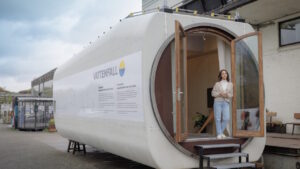The Gullen Range solar farm – the first in Australia to be co-located with a wind farm – has begun generation into the grid.
The 10MW solar farm is adjacent to the 165MW Gullen Range wind farm, and both are owned by New Gullen Range Wind Farm, a company owned 25 per cent by Chinese renewable energy giant Goldwind and 75 per cent by Beijing Jingneng Clean Energy.
Goldwind is also building the 20MW White Rock solar farm near Glen Innes in northern NSW, next to the White Rock wind farm, while Windlab is also planning to build a 60MW project comprising both wind and solar – and battery storage – at the Kennedy project in north Queensland.
That project could expand to 1,200MW, providing what its developers describe as “baseload” renewables for the region. CWP is also planning a large solar farm with battery storage to partner the Sapphire wind farm that is also being built in northern NSW.
DP Energy is looking to a solar-wind hybrid at its Port Augusta renewable energy park in South Australia, and APA is building a solar farm at Emu Downs to co-exist with the existing wind farm of the same name.
Gullen solar first produced in late August, and has been putting into the grid on a regular basis since around mid-September. This graph above, courtesy of the Climate and Energy College in Melbourne, shows the combined output of the solar and wind farms in the past week.
The Gullen Range solar farm attracted a $10 million grant from the Australian Renewable Energy Agency, even thought its projected costs – $2.6 million a megawatt – were well above the average of $2.16 million/MW from the projects that made its short-list for the recent large scale solar tender.
However, ARENA explained at the time that they were keen to see a co-located wind and solar farm, and estimated that there were 1,000MW of solar projects that could be co-located.
“Co-location provides more continuous energy generation, as wind farms tend to generate more energy overnight whilst solar only generates during the day. Gullen Wind Farm generates more power in winter and the new solar farm will generate more in summer,” ARENA boss Ivor Frischknecht said at the time.
“Wind farm owners across Australia could benefit from adding solar plants to their existing sites. Developers can save money on grid connection, approvals and site development costs by co-locating wind and solar plants, whilst also reducing environmental impacts.
Gullen Range was built by the Decmil Balance joint venture.
Note: The Gullen Range Wind Farm and Gullen Solar Farm are conducting Wind and Solar Farm Tours. The first tour will take place on Tuesday, 24th October at 11.30am.
It says The tours are a great opportunity for the community to visit Australia’s first hybrid wind and solar farm, which is located along SERREE‘s (South East Region of Renewable Energy Excellence) Renewable Energy Trail. For more information and to book a tour, click here.












